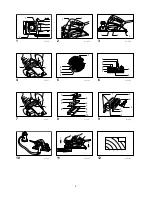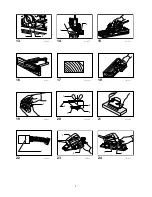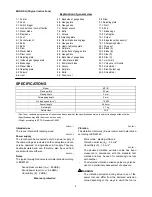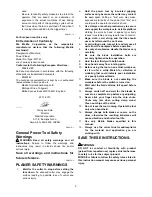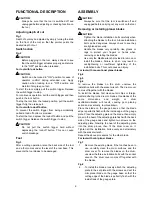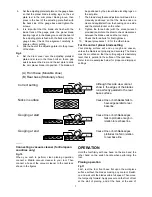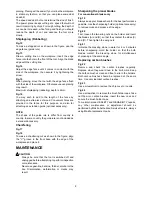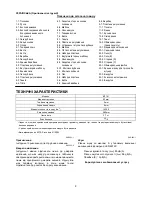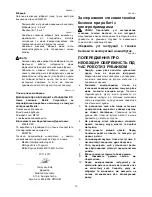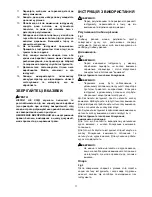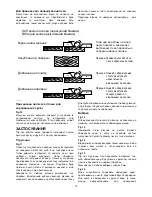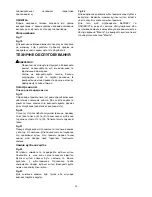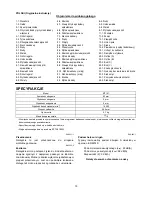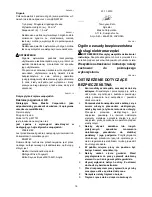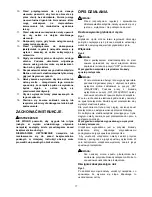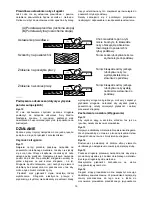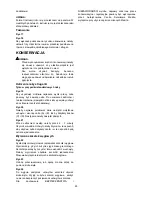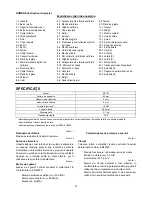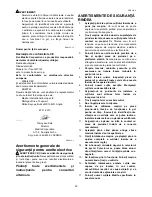
7
3.
Set the adjusting plate/set plate on the gauge base
so that the planer blade locating lugs on the set
plate rest in the mini planer blade groove, then
press in the heel of the adjusting plate flush with
the back side of the gauge base and tighten the
screws.
4. It is important that the blade sits flush with the
inside flank of the gauge plate, the planer blade
locating lugs sit in the blade groove and the heel of
the adjusting plate is flush with the back side of the
gauge base. Check this alignment carefully to
ensure uniform cutting.
5.
Slip the heel of the adjusting plate into the groove
of the drum.
Fig.9
6.
Set the drum cover over the adjusting plate/set
plate and screw in the three bolts so that a gap
exists between the drum and the set plate to slide
the mini planer blade into position. The blade will
be positioned by the planer blade locating lugs on
the set plate.
7.
The blade's lengthwise adjustment will need to be
manually positioned so that the blade ends are
clear and equidistant from the housing on one side
and the metal bracket on the other.
8. Tighten the three bolts (with the socket wrench
provided) and rotate the drum to check clearances
between the blade ends and the tool body.
9.
Check the three bolts for final tightness.
10. Repeat procedures 1 - 9 for the other blade.
For the correct planer blade setting
Your planing surface will end up rough and uneven,
unless the blade is set properly and securely. The blade
must be mounted so that the cutting edge is absolutely
level, that is, parallel to the surface of the rear base.
Refer to some examples below for proper and improper
settings.
(A)
(B)
(B)
(A)
(B)
(A)
(A) Front base (Movable shoe)
(B) Rear base (Stationary shoe)
Correct setting
Nicks in surface
Gouging at start
Gouging at end
Although this side view cannot
show it, the edges of the blades
run perfectly parallel to the rear
base surface.
Cause: One or both blades fails to
have edge parallel to rear
base line.
Cause: One or both blade edges
fails to protrude enough in
relation to rear base line.
Cause: One or both blade edges
protrudes too far in relation
to rear base line.
EN0004-1
Connecting a vacuum cleaner (for European
countries only)
Fig.10
When you wish to perform clean planing operation,
connect a Makita vacuum cleaner to your tool. Then
connect a hose of the vacuum cleaner to the nozzle as
shown in the figures.
OPERATION
Hold the tool firmly with one hand on the knob and the
other hand on the switch handle when performing the
tool.
Planing operation
Fig.11
First, rest the tool front base flat upon the workpiece
surface without the blades making any contact. Switch
on and wait until the blades attain full speed. Then move
the tool gently forward. Apply pressure on the front of tool
at the start of planing, and at the back at the end of
Summary of Contents for MT191
Page 11: ...11 11 12 13 14 15 16 17 Makita 18 Fig 1 Fig 2 Fig 3...
Page 12: ...12 Makita Fig 4 Fig 5 Fig 6 Fig 7 1 Fig 8 2 3 4 5 Fig 9 6 7 8 9 10 1 9...
Page 13: ...13 A B B A B A EN0004 1 Fig 10 Makita Fig 11 Fig 12 Fig 13 Fig 14 Fig 15 9 Fig 16...
Page 14: ...14 Fig 17 Fig 18 V Fig 19 Fig 20 D Fig 21 2 3 Fig 22 Fig 23 Fig 24...
Page 48: ...48 Makita Corporation Anjo Aichi Japan www makita com 885032 979...


